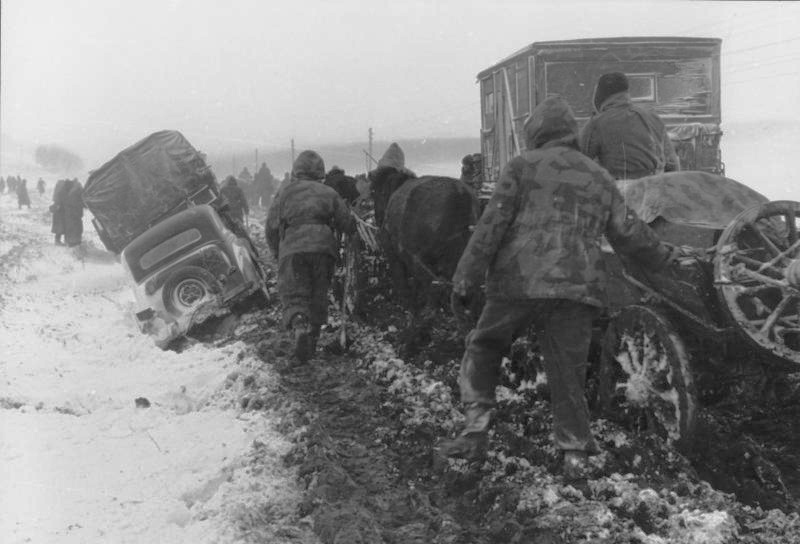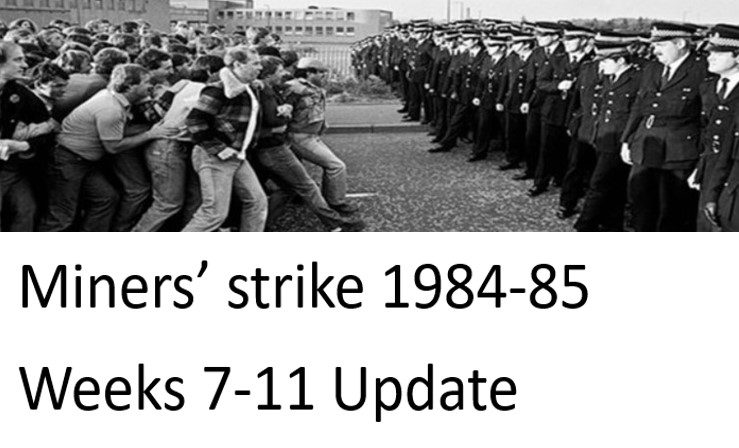Andy Ford (Warrington South Labour member) continues his occasional series on the Soviet military WW2 history. [Featured photo credit can be seen here]
The Battle of Korsun-Cherkassy in February 1944 is virtually unknown in the west, but it shouldn’t be, as it became a huge Nazi defeat, and the circumstances of that defeat had a shattering effect on the morale of the men involved.
After the German surrender at Stalingrad in February 1943 the Red Army was constantly trying to achieve another encirclement, but despite Hitler’s crazy idea of holding every metre of occupied land “to the last man and the last bullet”, the Wehrmacht were mainly able to retreat, if not in good order, at least without catastrophe, right across the eastern Ukraine. That all changed at Korsun-Cherkassy.
Hitler had designated a new eastern defensive line, the fancifully named Panther-Wotan line which ran from Lake Peipus in the north, across the Pripyat Marshes and then along the western bank of the River Dnieper to the Black Sea. In theory it was a strong defensive position as the west bank of the Dnieper is higher than the eastern. But in reality, it was only a line on a map – and when the bedraggled German troops arrived at the river the necessary construction work had barely started. As a result the Red Army crossed the Dnieper in many places after short engagements and Kiev was liberated in mid December.
Only one section of the line stood firm, which was the sector on the middle Dnieper, 120 miles south of Kiev, near the towns of Cherkassy and Korsun in central Ukraine. The sector was held by the German Eighth Army which comprised four infantry divisions, and two SS formations, the Wiking Division, raised from fascist sympathisers in the Scandinavian countries; and the SS Wallonien Brigade, recruited from French-speaking Belgians who were supporters of the far-right Rexist Party. By January this formidable force had ended up in an exposed bulge into the Red Army lines with exposed flanks of almost 65 miles.
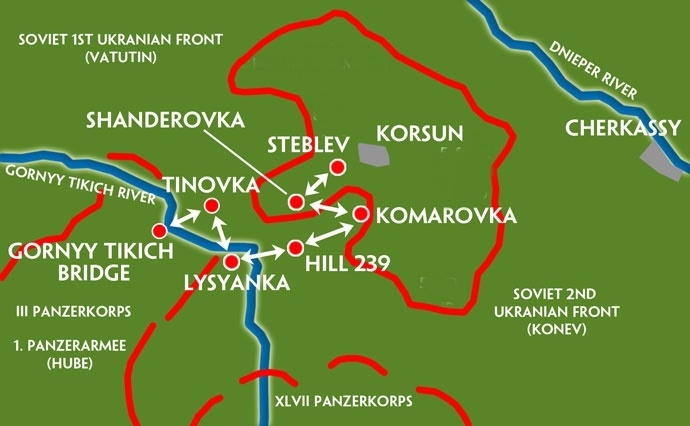
Straightaway the Soviets saw the opportunity and Marshal Zhukov ordered planning to commence for encirclement of the Eighth Army. The German generals saw the danger too, and requested Hitler for permission to withdraw. This was refused with Hitler bombastically designating the salient as a “fortress on the Dnieper”.
Red flood
As predicted the Red Army launched its attacks, on January 24th 1944. The Second Ukrainian Front under General Konev attacked from the north; and the First Ukrainian Front under General Vatutin, from the south. A German commander described what he saw, and the effect: “The red flood rolled over the tanks and artillery of the 3rd, 11th, and 14th Panzer Divisions around noon, heading west. The scene was amazing, dramatic, shocking…the dam broke and a great unending flood inundated the plain.”
The Red Army had deployed 400,000 men, 500 tanks and 1,000 aircraft. Just four days later, on January 28th the two Soviet forces met at the village of Zvenigorodka, on the banks of the river Gniloy Tykich.
60,000 Nazi troops were now encircled, although the encirclement was tenuous at several points. One tragic event was that the leader of the Soviet northern pincer was killed by friendly fire when they met the other prong of the Soviet attack. A Red Army soldier, Dmitri Loza, recorded in his memoir, “As tanks approached from the south, our Shermans drove from the north. Our men in the T-34s weren’t warned that our Shermans were there and they set the tank of the battalion commander, Nikolai Nikolaevich Maslyukov, ablaze and killed him.”
The task of the Germans should have been to break through and try to rescue their Eighth Army. But again, Hitler interfered, ordering his generals to counter-encircle the Soviet spearheads, destroy them, and then move up the west bank of the Dnieper to recapture Kiev! They knew it was impossible, sheer wishful thinking, with the battered troops under their command, but had to obey the dictator’s orders. The counter encirclement made little progress but wasted most of a week, in which time the German pocket had shrunk to about 30 square miles round the town of Korsun.
Now Hitler’s star general Erich von Manstein tried to break through to the surrounded troops. He had been set the task of relieving Stalingrad, and had failed. He was determined that history would not repeat itself. But just as his forces began the relief attempt, the weather broke and the frozen ground dissolved into a sea of mud. The German heavy tanks, like the Tiger and Panther, often sank deep over the tracks into the mud and had to be pulled out – and only another Tiger had the power to pull it out! Even worse, sometimes the tanks froze in the mud overnight and had to be laboriously dug out next morning. One Panzer battalion made just 5 miles in 12 hours. And then the Tigers ran out of fuel and ammunition just 5 miles from the besieged troops. It proved incredibly difficult to supply the armoured divisions using the few roads crossing the marshy land beside the Dnieper. They could do no more.
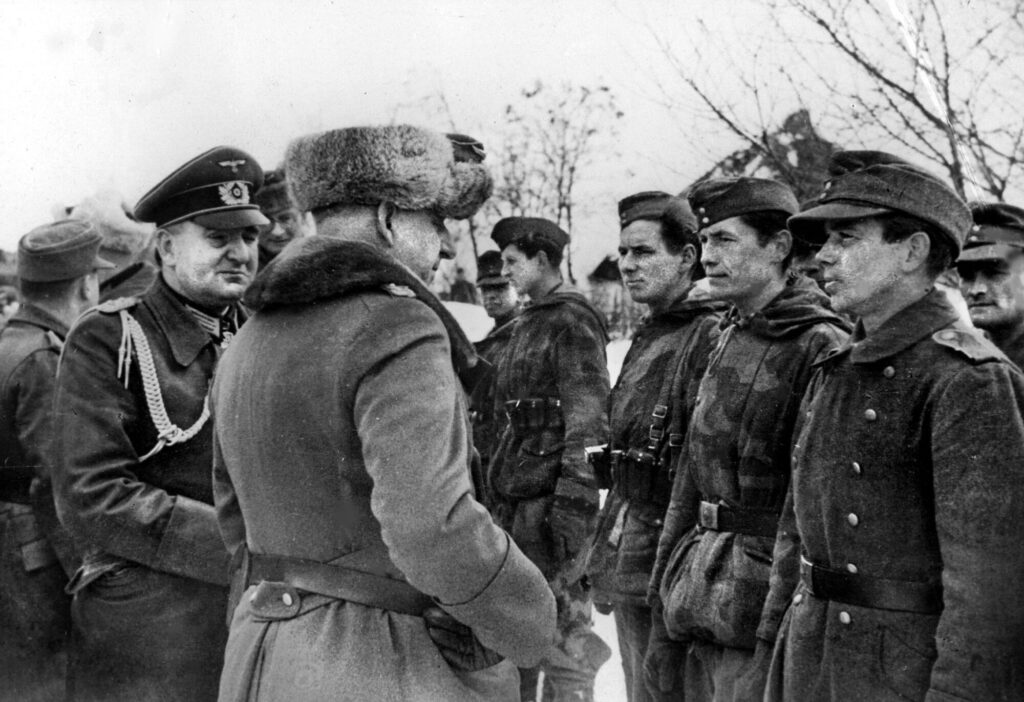
meets his troops near Cherkassy Feb 1944.
All that was left was a breakout by the besieged troops. By February 15th the pocket had shrunk to a strip of territory three miles by five, packed with thousands of men, starving, sleepless, and defending in all directions. The Soviet high command expected an imminent surrender and in fact promised this to Stalin.
War of annihilation
But the Germans had no confidence in surrender. The SS troops were nearly always shot out of hand, hardly surprising after all the atrocities they had committed across the Soviet Union. But even for the enlisted men, Soviet captivity was a source of dread. This was due to Stalin replying to Hitler’s stated aim of “annihilation” of the Soviet Union and Russian people with his own declaration of a “war of annihilation”, which was, incidentally, completely opposite to the policy pursued by Lenin and Trotsky in the Russian Civil War.
In the Civil War the ranks of the White armies melted away in the face of the Bolshevik’s social programme, but also strict instructions were issued to the Red Army soldiers not to mistreat rank and file prisoners. Of course such instructions were not universally followed in the heat of battle, and in fact Stalin was one of the worst offenders, but that was the aim. The result was to limit the number of desperate last stands and to separate the White officers from their men. There were many examples of White formations arresting their officers and turning them over to the Bolsheviks.
The dirty, hungry and frozen German soldiers were therefore formed up into three columns on February 16th. Marching at night the plan was to ambush the Soviet lines with bayonets, move through them and race for the territory won by the relieving forces. The men in the first line were told to unload their weapons so that an accidental shot could not alert the Soviet troops. One German regiment even encountered a Red Army tank column in the night, which waited patiently for the soldiers to march past, assuming they were Soviet infantry on their way to a dawn attack.
The night assault worked as planned. The Soviet forces were complacently waiting for surrender, instead of which they were suddenly confronted at dawn by thousands of desperate armed men, headed up by the SS.
But once they were through the Soviet first lines, German military order broke down and a disorderly mob of around 20,000 soldiers surged forward to what they hoped was safety. In at least one case they ran straight into a belt of Soviet machine guns, others were mown down by Soviet tanks, and General Konev at one point even unleashed his Cossack cavalry to hunt down the fleeing Nazis, one of the last cavalry charges of WW2.
Nevertheless, many thousands of German soldiers reached the banks of the Gniloy Tykich river near the village of Lysanka, at that point about 20 yards wide, 20 feet deep and fast-flowing with ice floes. On the other side was the German army. A German general described the scene:
“Many soldiers were entirely without weapons; quite a few even without footgear. Neither division could be considered in any way able to fight. One regiment was intact and still had some artillery support. However, this regiment also had no vehicles and no rations left. “
German losses
But the one bridge was several miles upriver, and some German troops did reach it and cross the river ‘dry’. But the majority faced a choice between waiting on the bank to be massacred by Soviet tanks or air strikes, or else jumping in the freezing cold waters and attempting to reach the other side. Thousands did take that chance, and hundreds were swept away, drowned, or succumbed to hypothermia. Later, engineers succeeded in laying tree trunks across the river and stragglers were able to cross for days afterwards.
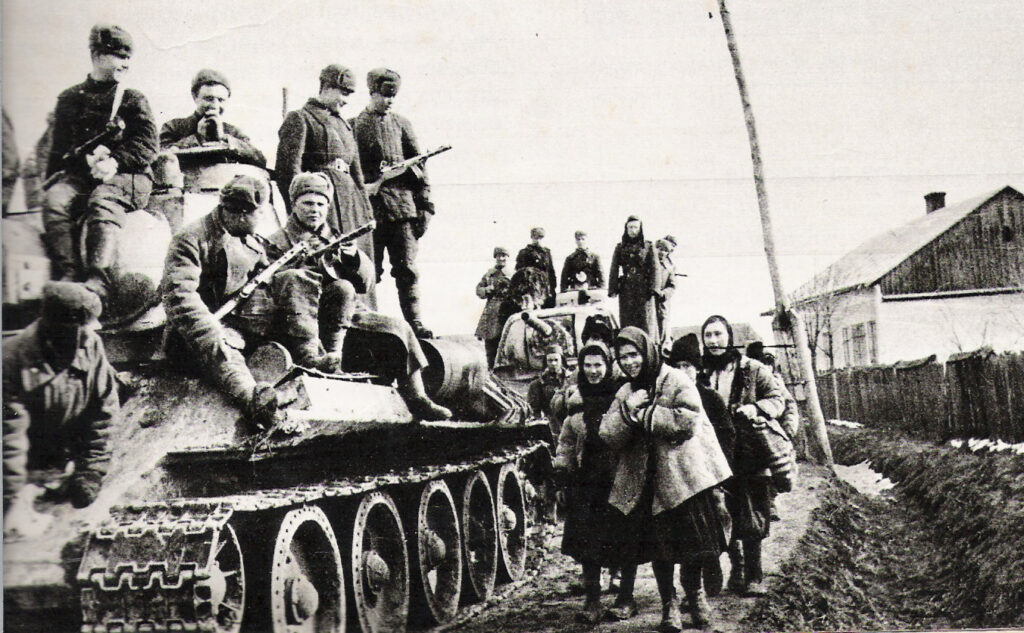
(photo credit here)
The Germans lost about 30,000 men, and all their equipment. Another 30,000 made it out, but it had been a shattering experience. Far from being the ‘master race’, the SS and German infantry had spent days without food, stumbling through the mud and undergrowth while being hunted down by the Red Army, and then having to take their chances in the frozen river. The fact that there were so many survivors was not good for morale in the rest of the Wehrmacht either as they could tell them what it had been really like, not the Nazi fairy tale of a well organised rescue of beleaguered heroes.
One account described how, “Later that day, a column of German soldiers straggled over the horizon, partially made up of troops pushed from Cherkassy. Seven or eight ragged, famished regiments, overloaded with wounded, descended on us like a plague of locusts, ravaging and plundering our reserves. The intensity of the battle they had just survived could easily be read on their shaggy, exhausted faces. This fragment of the Wehrmacht, with worn out boots, empty packs, and eyes glittering with fever…”
Stalin and his propagandist hyped the battle as a ‘Stalingrad on the Dnieper’ but although it was a massive blow to the Nazi war machine, it wasn’t quite Stalingrad. Also Stalin, as he often did, tried to stoke rivalries between his commanders, by attributing the victory to the Second Ukrainian Front, led by Konev and conspicuously failing to mention the First Ukrainian Front, led by Vatutin. Marshal Zhukov vigorously criticised this in his memoirs. It was exactly this behaviour by Stalin that contributed to the failure of the Red Army at Warsaw in 1920, and which was criticised by Trotsky. The same thing happened in the Battle of Berlin in 1945, and cost a lot of Soviet soldiers their lives. But it helped maintain Stalin’s hold on power.
In military terms, Korsun-Cherkassy unravelled the whole German line in Ukraine. In the north the Soviets cleared the southern edge of the Pripyat marshes, with nothing to stop them until the Carpathian Mountains. In the south the Germans were forced from Krivoi Rog with its huge iron ore deposits and manganese, a key metal for military production. And the retreat from the southern Dnieper made the defence of Crimea all but impossible.

